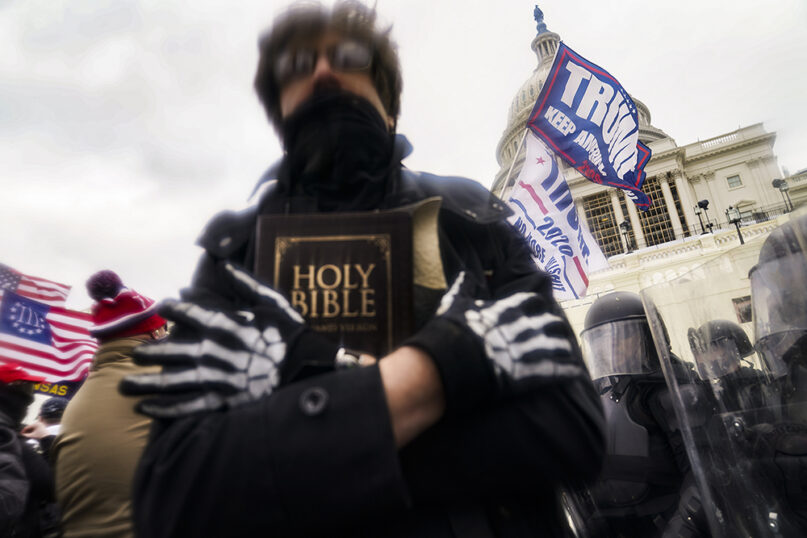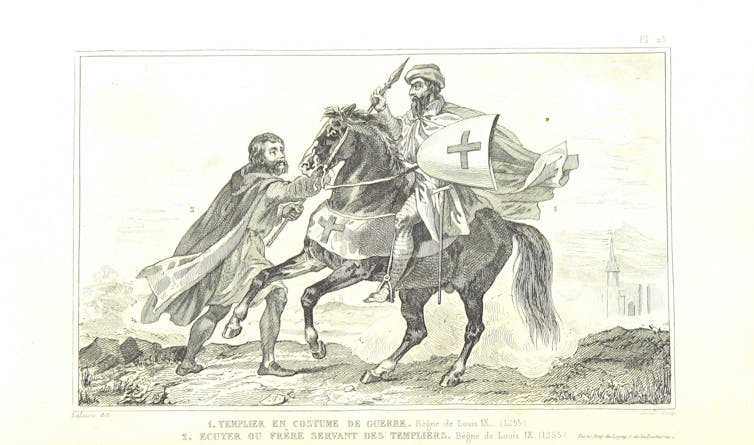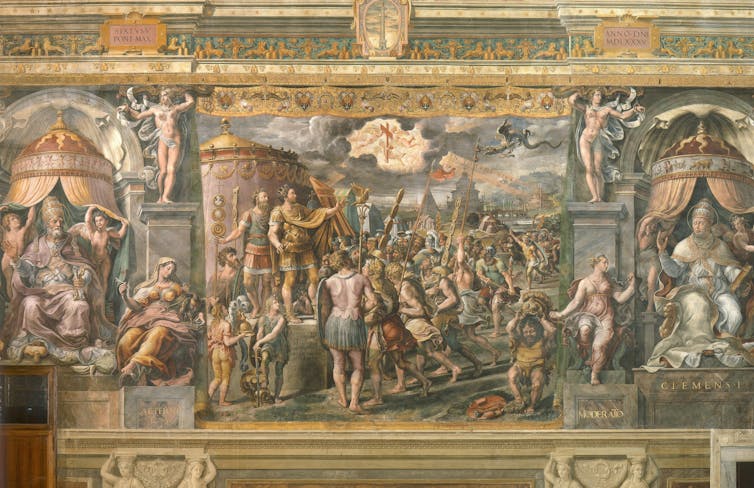Leveraging social media, these parents and professionals aim to show that this parenting approach can result in trauma, estrangement and views of God as abusive.

(Photo by Monstera Production/Pexels/Creative Commons)
May 30, 2024
By
Kathryn Post
(RNS) — For Tia Levings, it was blanket training.
A method where a parent places an infant or toddler on a blanket and punishes them — often by hitting them — if they stray, blanket training was a line Levings refused to cross, and a technique that made her question the teachings that enveloped her as a young mother in the Christian patriarchy movement.
“We were not to listen to our instincts,” said Levings, who raised her kids in Jacksonville, Florida, in the 1990s. “Our mother instincts would lead us to make weak choices that cater to the flesh, and instead we needed to raise our babies the way God would.”
When Levings spoke about corporal punishment in the hit documentary series “Shiny Happy People,” her story didn’t just resonate with viewers raised in fundamentalism. Though the series focused on Bill Gothard’s Institute in Basic Life Principles, the idea that spanking results in obedient, righteous children was a hallmark of mainstream evangelical parenting in the ’70s-’90s.
“Dobson taught people, spank your kid, but sit them down and put them on your lap and hug them,” therapist Krispin Mayfield said about psychologist and Focus on the Family founder James Dobson, whose book “Dare to Discipline” has sold more than 3.5 million copies since 1970. This combination of pain and affection, Mayfield told Religion News Service, can shape how children view parents and authority figures. And, according to Mayfield and Levings, it can impact their view of God.

Tia Levings. (Courtesy photo)
“It leaves you without any spiritual solace,” said Levings, author of the forthcoming book “A Well-Trained Wife: My Escape From Christian Patriarchy.” “You don’t know where to turn for any kind of safe spirituality because the Divine was used … as the justification for why you were being hurt.”
In the late 20th century, a specific, often white evangelical brand of authoritarian parenting emerged. Framed as being God-glorifying, it was characterized by rigid hierarchies, demands for children’s immediate and cheerful obedience and the absence of negative emotions among children. It was enforced by spanking, often starting when a child was just a few months old.
Now, some of the adults raised in that context are pushing back. Leveraging social media, they aim to show that this parenting approach can result in trauma, estrangement and a view of God as abusive. Their warnings are often paired with a plea to raise kids in a way that honors children’s agency.
Books like Dobson’s were an explicit response to the perceived disruptions of the feminist movement, Civil Rights Movement, Vietnam War protests and 1960s youth culture, several experts told RNS. Evangelical authoritarian parenting prioritized parental authority as a stabilizing force and were also an answer to parenting models seen as permissive, including those popularized by such authors as Dr. Benjamin Spock and, later, Dr. William Sears.
As Dobson’s reach extended beyond the evangelical parenting world, other self-appointed experts such as Gothard, Tedd Tripp, Gary Ezzo, Michael and Debi Pearl and Nancy Campbell emerged. Their advice proliferated via conferences and parenting books, some with provocative titles such as Larry Tomczak’s “God, the Rod, and your Children’s Bod” or Reb Bradley’s “Born Liberal, Raised Right: How to Rescue America from Moral Decline.”
Author Marissa Burt said that, barring Dobson, most of these authors were pastors who lacked relevant credentials.
“They marketed themselves well, they made claims to spiritual authority, they generated fear in parents, and they presented their opinion as God’s way to hundreds of thousands of people,” said Burt.

Marissa Burt, left, and Kelsey Kramer McGinnis. (Burt photo by Janeen Sorensen 2021; McGinnis photo © 2024 KC McGinnis)
Together, these authors created a cohesive movement or, as Burt and scholar Kelsey Kramer McGinnis say in their forthcoming book, from Brazos, a “Christian parenting empire.” These writers viewed parents as God’s representatives charged with using physical punishment to enforce instant obedience, constant composure, strict hierarchies and gender binaries. This approach, parents were taught, would preserve the nuclear family and, by extension, society as a whole — and would prevent their children from losing their souls.
“Parents are being told, you have to do this or your kid is going to either end up in hell, or end up a criminal,” said R.L. Stollar, author of “The Kingdom of Children.”
As writers D.L. and Krispin Mayfield note in their new multimedia “Strongwilled” project, these authors often rejected the authoritarian label. But the Mayfields developed the term “religious authoritarian parenting” to discuss those like Dobson, Gothard and the Pearls whose impacts and techniques, they argue, are nevertheless authoritarian in nature.
“It wasn’t marked by having to wear skirts or like not going to the movies or those sorts of things. It was marked by, do you submit to the authority figures in your life?” Krispin Mayfield said.

Krispin, left, and D.L. Mayfield. (Courtesy photos)
For many parents, the promises of this movement never materialized. Rather than a lifetime of happiness with compliant, Christian children, several sources told RNS, parents in some cases have become estranged from children who eventually sought autonomy beyond the parent-child relationship.
“The parents feel utterly betrayed, and the only way they can handle that is by saying, I didn’t do something wrong. It’s my children. They are not grateful for the sacrifices that I made,” said Abbi Nye, an anti-abuse advocate raised with the Quiverfull ideology, often characterized by large families, homeschooling and female submission. Parents who refuse to acknowledge the harm caused by Christian authoritarian parenting, she said, risk alienating their kids long-term.
Nye is one of several Christians and former evangelicals, or exvangelicals, speaking out against Christian authoritarian parenting and seeking different approaches. As she teaches her son to regulate, rather than stifle, his emotions, she said, she draws inspiration from child liberation theology, an emerging Christian movement that says children have the same worth as adults.

Abbi Nye in New York in 2023. (Courtesy photo)
One of the leaders of that field is Stollar, a child of evangelical parents who were “somewhat resistant adopters of some of the more authoritarian aspects of parenting,” he told RNS. Now, he argues in blogs and articles that adults can parent without exerting force to exact compliance.
“I want parents to know there are different ways to read the Bible that are valid, that understand and respect who Jesus and God are, and are still treating children in a way that is humane and respectful,” said Stollar.

R.L. Stollar. (Courtesy photo)
Deciding to parent differently than their evangelical parents was part of what led the Mayfields to eventually depart Christianity. Their “Strongwilled” project suggests kids raised by religious authoritarian parenting are more susceptible to political authoritarianism — including that of Donald Trump.
“We’ve been traumatized for political purposes,” D.L. Mayfield told RNS. “All of this was done to undo the progress made in the 1950s in the United States of America … and us as kids, we’re just collateral damage.” Through “Strongwilled,” the Mayfields hope to build a community for those reckoning with their childhoods.
As they share findings from their book research, Burt and McGinnis, both Christian parents themselves, have reached hundreds of people trying to unpack the Christian parenting empire they belonged to. People who’ve left Christianity, too, tune in to YouTube or Instagram to hear Burt and McGinnis discuss corporal punishment, perfectionism and spiritual authority in Christian parenting.
“There’s a way to talk about this that is absolutely accusing my parents’ generation of being either these authoritarian, spiritual tyrants or just sheep to people like James Dobson, and neither of those is true,” said McGinnis, who is also a correspondent for Christianity Today. “I think there’s a way to talk about this that welcomes those folks. So I’m really thankful when someone from that camp chimes in.”
RELATED: Child liberation theology says God is a child, too

Yolanda Williams. (Courtesy photo)
The parents and professionals analyzing the previous generation’s Christian parenting are doing so amid a culturewide shift away from punitive parenting tactics. But as gentle and conscious parenting becomes more mainstream, it can also become whitewashed, warned parenting coach Yolanda Williams, who argues that true conscious parenting — which teaches parents to be mindful of their own trauma — must reckon with how colonization interrupted Indigenous parenting methods.
“There were reports that Indigenous people were appalled by the way that the Europeans treated their children like property,” Williams, creator of the Parenting Decolonized social media accounts and resources, said. “The roots of conscious parenting are from Black, Indigenous and other people of color.”
But though the tides of parenting culture seem to have turned, some artifacts of Christian authoritarian parenting have remained, with new iterations gaining popularity on social media, where self-platformed experts and “tradwife” influencers have been doling out parenting advice in what they see as a revival of old-fashioned Christian family values. To those raised in the original Christian parenting empire, these freshly packaged lessons about obedience, discipline and strict gender roles are grimly familiar.
“Whether we are exvangelicals, whether we still consider ourselves Christians, wherever we are on the political spectrum, we’re saying, what we experienced was not OK,” said Nye. “We want to warn the next generation.”













